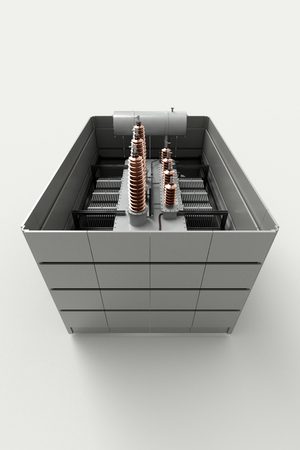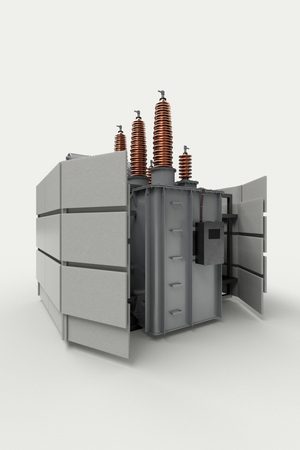Next-Generation Ballistic Protection Ensures Long-Term Utility Security
In July 2014, the Department of Homeland Security mandated that utilities meet requirements and measures outlined in the North American Electric Reliability Corporation’s (NERC’s) critical infrastructure protection (CIP) standards. These standards regulate the physical safety and security of all aspects of the power grid, including energy substations and generators. They outline steps toward prioritizing which equipment needs protection, assessing and verifying risk, sharing that information, and implementing physical security measures.
One aspect of these standards is evaluating any prior history of attack or past physical security events on similar facilities. It also includes reviewing any intelligence or threat warnings received from sources such as law enforcement, NERC, the Electricity Sector Information Sharing and Analysis Center (ES-ISAC), or U.S. federal and/or Canadian governmental agencies.
In previous years, this evaluation may have indicated that minimal physical security measures met NERC CIP-014 standards. However, in recent years, the instances of physical attacks have increased. According to the Department of Energy (DOE), 2022 saw a 77% increase in power grid attacks compared to 2021. Unfortunately, this trend seems set to continue—with the first quarter of 2023 showing twice the number of attacks as the first quarter of 2022, according to the DOE.
With this data and the increasing demand for electricity, utilities may find in their 30- and 60-month re-evaluations that more substations need to bolster their physical security. Given the rise of attacks on the power grid, this may include more robust ballistic protection systems. It is important to note that implementation of physical security measures must occur within 120 days of the verification of risk assessment.
To meet this timeline and to provide enhanced physical protection to the power grid, it is becoming increasingly crucial to introduce ballistic protection systems that can be deployed rapidly without compromising the level of protection provided. Developed collaboratively between the utility operation and security communities, select next-generation ballistic protection features important elements that safeguard today’s utilities as well as tomorrow’s growth, including modular construction and the incorporation of detection and notification systems. These qualities come together to provide premier ballistic protection for utilities and those who rely on them for power.
The Benefits of Modular Protection
Previously, guarding against the destruction of vulnerable energy transmission systems from ballistic attack was almost exclusively relegated to perimeter solutions, such as wall structures. While appearing formidable, these measures, often made of concrete, steel, and other like materials, offer little deterrence to a determined attacker. In addition, their deployment is both expensive and time consuming as these structures are extremely heavy and require substantial footings for support. Due to their construction requirements, these structures can often only be placed at a distance from the systems they protect, which significantly reduces their effectiveness—especially when threats come from above. Simply put, these solutions, while helpful, do little to mitigate current and emerging ballistic threats.
Newly available panel-based or “modular” ballistic barrier systems (Figure 1) sideline many of the issues encountered when protecting these vulnerable systems. These forward-thinking solutions can both mitigate damage from ballistic attack and meet other pragmatic concerns, including installation timelines and day-to-day operation. They can immediately surround and easily adapt to energy transmission equipment of any size and dimension, including large high-voltage transmission transformers. Such flexibility is important given that equipment size, shape, and location constraints vary greatly between the more than 55,000 substations located across the U.S. alone.

Lightweight and non-conductive, this new generation of ballistic barrier is designed for direct application to the energy structures they protect. As a result, they offer significantly improved ballistic protection from bullets as well as blast fragmentation—from all sides, including above. In addition to physical protection from attack, these modular systems also utilize composites with thermal barrier properties proven effective at managing temperature extremes (Figure 2) to address the needs of utility operators. This helps reduce stress on equipment, improving its overall performance and extending its service life.

Also worth noting is the simplicity and speed at which these modular systems can be deployed. In contrast to traditional wall construction techniques, which commonly involve digging foundations for support, modular ballistic barriers can be readily applied to existing equipment. This eliminates many, if not all, required permits and negates risk of potential damage to buried conduit commonly located throughout energy transmission system sites. As a consequence, deployment timelines are dramatically reduced from weeks or months to days.
Lastly, modular construction also allows for efficient replacement of individual panels if damaged—significantly reducing both the expense and time needed for repair. Further, due to their flexibility and quick installation timelines, modular ballistic protection systems can meet a variety of project constraints—including timing deadlines indicated in the NERC CIP-014 standards. This helps protect today’s critical infrastructure while also anticipating future needs.
AI-Powered Detection and Notification Capabilities Usher in the Next Generation of Ballistic Protection
Unfortunately, the majority of attacks on substations remain unsolved—including the attack in Moore County, North Carolina, in December 2022 that left thousands without power in the height of winter. This is often due to the use of high-powered rifles, which allow attackers to damage or destroy these systems from a distance. Secondly, many substations are remote or strategically placed out of sight, allowing few options for effective surveillance.
Quickly addressing ballistic attacks and their ensuing damage is necessary to assure continuous energy delivery. Historically, these systems have proven to be extremely vulnerable since awareness of an attack often only occurs well after complete system failure. This results in loss of service and equipment, a significant expense. Using modular ballistic protection systems that are coupled with state-of-the-art ballistic detection and notification technology can both mitigate damage and support heightened awareness of attacks in real time.
This new energy-wave technology not only detects and notifies, but it also provides critical data that is analyzed onsite. The data both determines the occurrence of a ballistic attack and distinguishes a ballistic event as either bullet or blast. This provides utility personnel and first responders with more information and can also help keep them safe. Detection and notification technology is also capable of identifying the locations of both the damage and shooter while also initiating the appropriate response. This can include notification of all parties and autonomous instruction of physical security assets, such as articulating cameras, surveillance drones, and other robotics. It does this all within seconds and without human intervention.
By “surrounding the tool”—a phrase used in the semiconductor manufacturing industry—with next-generation ballistic protection systems (Figure 3) that include energy-wave technology, utilities can safeguard their energy transmission equipment, and reduce immediate and long-term vulnerabilities.

Looking Toward the Future with Ballistic Protection That Is a Complete System
The U.S. Energy Information Administration (EIA) projects the residential consumption of electricity will increase by 14% to 22% by 2050. In the same report, industrial consumption is projected to increase by up to 32%. As demand for electricity increases, providing critical protection to the power grid will continue to see added emphasis.
This emphasis is expected to translate to more robust protection around established substations and other equipment, as well as additional measures for new and previously less-protected facilities. Modular panel-based ballistic protection is customizable to a wide range of project constraints. It is also adaptable as substations are redesigned or added to existing infrastructure. They also serve as a platform to deploy newer technologies to combat threats such as fire, as well as other emerging threats. These qualities will help provide long-lasting ballistic and other protection, even as the nature of the power grid shifts.
As physical security becomes more integral to energy generation and supply, it is important that security measures work in tandem with day-to-day utility operation. Systems that protect should be developed collaboratively between the security and utility operation communities, as was the development of the aforementioned modular panel-based ballistic protection system. Both capabilities—protection and daily operation compatibility—are crucial for ensuring long-term power grid protection.
—Jeffrey Isquith is founder and CEO of Amulet Protective Technologies and Amulet Critical Infrastructure—an engineering, design, and manufacturer of innovative physical security solutions to protect life and property from ballistic violence.